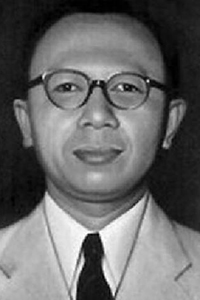 Djuanda Kartawidjaja is an Indonesian government figure that has served as the 10th Prime Minister and Minister of Finance. He was known for the Declaration of Djuanda in 1957. Djuanda was born in Tasikmalaya, January 14th, 1911. He completed secondary education at Hoogere Burgerschool te Bandoeng before proceeding to obtain his bachelor’s degree in civil engineering at Technische Hoogeschool te Bandoeng (ITB). The Declaration of Djuanda states that Indonesia has absolute sovereignty over all the waters within straight baselines between its outermost islands. The statement serves as the foundation for regulations which replaced the Territoriale Zee en Maritime Kringen Ordonantie in 1939. Djuanda passed away in Jakarta at the age of 52 in 1963. Several important infrastructures were named after him, such as Juanda International Airport in Surabaya, Ir. H. Djuanda Forest Park and Ir. H. Djuanda Museum and Monument in Bandung, Ir. H. Djuanda Street in Jakarta, and Juanda Station in Jakarta. In addition to infrastructure, his name and figure is honored on the Rupiah 50.000 bill.
Djuanda Kartawidjaja is an Indonesian government figure that has served as the 10th Prime Minister and Minister of Finance. He was known for the Declaration of Djuanda in 1957. Djuanda was born in Tasikmalaya, January 14th, 1911. He completed secondary education at Hoogere Burgerschool te Bandoeng before proceeding to obtain his bachelor’s degree in civil engineering at Technische Hoogeschool te Bandoeng (ITB). The Declaration of Djuanda states that Indonesia has absolute sovereignty over all the waters within straight baselines between its outermost islands. The statement serves as the foundation for regulations which replaced the Territoriale Zee en Maritime Kringen Ordonantie in 1939. Djuanda passed away in Jakarta at the age of 52 in 1963. Several important infrastructures were named after him, such as Juanda International Airport in Surabaya, Ir. H. Djuanda Forest Park and Ir. H. Djuanda Museum and Monument in Bandung, Ir. H. Djuanda Street in Jakarta, and Juanda Station in Jakarta. In addition to infrastructure, his name and figure is honored on the Rupiah 50.000 bill.
 Samaun Samadikun is an esteemed Indonesian engineer famous for his diligence in the development of microelectronics in Indonesia. Born in Magetan in 1931, Samaun chose to study electrical engineering at ITB. Unfortunately, he was unable to complete as his education to the worsening of Indo-Dutch relations, which caused Dutch lecturers at ITB to leave for their homeland. Thankfully, Samaun received an offer to complete his study abroad in the United States. Based on an evaluation by Stanford University, Samaun was able to pursue a master’s degree despite not having completed his bachelor’s. Upon graduation Samaun worked as a lecturer at ITB before returning to Stanford to achieve his Ph.D. In hindsight, he would have been able to acquire great fortune if he took part in the development of Silicon Valley, but he chose to return to Indonesia and build ITB. Samaun was able to patent a method for forming regions of predetermined silicon. He dreamed of creating a city similar to Silicon Valley in Indonesia to advance microelectronics, branded Bandung High Tech Valley. Unfortunately, the dream was unable to come to actualization before his death in 2006. Nevertheless, his ambition has become a strong foundation for the development of microelectronics in Indonesia.
Samaun Samadikun is an esteemed Indonesian engineer famous for his diligence in the development of microelectronics in Indonesia. Born in Magetan in 1931, Samaun chose to study electrical engineering at ITB. Unfortunately, he was unable to complete as his education to the worsening of Indo-Dutch relations, which caused Dutch lecturers at ITB to leave for their homeland. Thankfully, Samaun received an offer to complete his study abroad in the United States. Based on an evaluation by Stanford University, Samaun was able to pursue a master’s degree despite not having completed his bachelor’s. Upon graduation Samaun worked as a lecturer at ITB before returning to Stanford to achieve his Ph.D. In hindsight, he would have been able to acquire great fortune if he took part in the development of Silicon Valley, but he chose to return to Indonesia and build ITB. Samaun was able to patent a method for forming regions of predetermined silicon. He dreamed of creating a city similar to Silicon Valley in Indonesia to advance microelectronics, branded Bandung High Tech Valley. Unfortunately, the dream was unable to come to actualization before his death in 2006. Nevertheless, his ambition has become a strong foundation for the development of microelectronics in Indonesia.
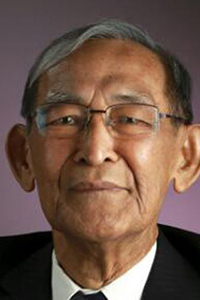 Wiratman Wangsadinata was the Founder and Managing Director of PT. Wiratman & Associates, Multidisciplinary Consultant, which has been established since 1976 and until now has been involved in the planning and supervision of hundreds or even thousands of construction projects ranging from bridges, dams, roads and quite a lot of tall buildings. He was the one who initiated the earthquake regulations in Indonesia. Although he was successful in the field of practitioners, and his existence was recognized in the civil engineering community, but because of his love for the world of civil engineering he continued to conduct dissertation research. After successfully completing a doctoral program and graduating cum-laude, a few years later he became a professor at Institut Teknologi Bandung. Prof. Dr. Ir. Wiratman Wangsadinata was born in Jakarta, February 25, 1935, and took his last breath on April 5, 2017. Prof. Wiratman will forever be remembered as a master of infrastructure in Indonesia. His dedication and influence for decades in the field of infrastructure development has always been the foundation in the development of Civil Engineering science.
Wiratman Wangsadinata was the Founder and Managing Director of PT. Wiratman & Associates, Multidisciplinary Consultant, which has been established since 1976 and until now has been involved in the planning and supervision of hundreds or even thousands of construction projects ranging from bridges, dams, roads and quite a lot of tall buildings. He was the one who initiated the earthquake regulations in Indonesia. Although he was successful in the field of practitioners, and his existence was recognized in the civil engineering community, but because of his love for the world of civil engineering he continued to conduct dissertation research. After successfully completing a doctoral program and graduating cum-laude, a few years later he became a professor at Institut Teknologi Bandung. Prof. Dr. Ir. Wiratman Wangsadinata was born in Jakarta, February 25, 1935, and took his last breath on April 5, 2017. Prof. Wiratman will forever be remembered as a master of infrastructure in Indonesia. His dedication and influence for decades in the field of infrastructure development has always been the foundation in the development of Civil Engineering science.
 Prof. Tjia May On is a professor at FMIPA ITB Magnetic and Photonic Physics expertise group. He graduated from ITB Physics Undergraduate Program in 1962, then he pursue his postgraduate program at Northwestern University USA and received his Ph.D in 1969 in Particle Physics.
Prof. Tjia May On contribute in establishing the Postgraduate Program in Optoelectronics and Laser Applications at University of Indonesia in 1976 and has recorded 158 publications in international journals, with 722 citations, and in collaboration with 157 co-authors who produced an h-index 19.
He was born in Probolinggo, December 25th 1934 and passed away on November 5th 2019. During his life in ITB, he was awarded with Bakrie Award in 2012 from Freedom Institute. In addition, he also received Anugerah Sewaka Winayaraha 2007 from Indonesia government for his contribution in Indonesia’s higher education, Ganesa Cendikia Widya Adiutama 2009 from ITB for his international publications in the field of material physics, and the 2016 Sarwono Award from LIPI for scientific research and his dedication in developing scientific research culture in Indonesia. He is also a member of the editorial board at Journal of Nonlinear Optical Physics and Materials since 2004.
Prof. Tjia May On is a professor at FMIPA ITB Magnetic and Photonic Physics expertise group. He graduated from ITB Physics Undergraduate Program in 1962, then he pursue his postgraduate program at Northwestern University USA and received his Ph.D in 1969 in Particle Physics.
Prof. Tjia May On contribute in establishing the Postgraduate Program in Optoelectronics and Laser Applications at University of Indonesia in 1976 and has recorded 158 publications in international journals, with 722 citations, and in collaboration with 157 co-authors who produced an h-index 19.
He was born in Probolinggo, December 25th 1934 and passed away on November 5th 2019. During his life in ITB, he was awarded with Bakrie Award in 2012 from Freedom Institute. In addition, he also received Anugerah Sewaka Winayaraha 2007 from Indonesia government for his contribution in Indonesia’s higher education, Ganesa Cendikia Widya Adiutama 2009 from ITB for his international publications in the field of material physics, and the 2016 Sarwono Award from LIPI for scientific research and his dedication in developing scientific research culture in Indonesia. He is also a member of the editorial board at Journal of Nonlinear Optical Physics and Materials since 2004.
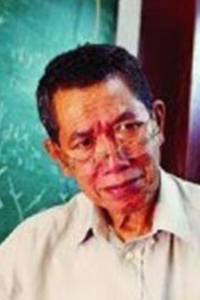 Prof. Pantur Silaban is an Indonesian physicist. He became a professor of theoretical physics at Institut Teknologi Bandung in January 1995 and is known as Indonesia's first physicist (even Southeast Asia) in the theory of relativity, especially general Relativity, which is classified as rare in his field. He is declared as the first Indonesian to explore Einstein's theory of relics because of his findings on Quantum Gravity Theory by combining the theory of Quantum Fields and General Relativity. The theory was previously mentioned by experts is a theory that Einstein wants to explore more deeply. He is known as someone who is interested in everything about nature, he often even provides material on natural development from the micro level to the universe at various events such as seminars and symposiums both national and international. He was awarded the Bakrie Award in 2009.
Prof. Pantur Silaban is an Indonesian physicist. He became a professor of theoretical physics at Institut Teknologi Bandung in January 1995 and is known as Indonesia's first physicist (even Southeast Asia) in the theory of relativity, especially general Relativity, which is classified as rare in his field. He is declared as the first Indonesian to explore Einstein's theory of relics because of his findings on Quantum Gravity Theory by combining the theory of Quantum Fields and General Relativity. The theory was previously mentioned by experts is a theory that Einstein wants to explore more deeply. He is known as someone who is interested in everything about nature, he often even provides material on natural development from the micro level to the universe at various events such as seminars and symposiums both national and international. He was awarded the Bakrie Award in 2009.
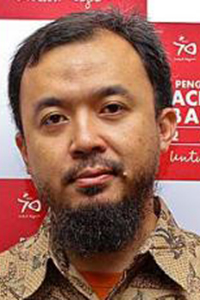 Yogi Ahmad Erlangga is often called as Young Habibie for his groundbreaking invention in mathematics. He majored in Aerospace Engineering in Bandung Institute of Technology and graduated in 1993. Later, he pursued his masters and doctoral degree in applied mathematics in Delft University, Netherlands. For his thesis, he managed to successfully solve Helmholtz equation with numerical mathematics in a robust manner. This equation was notorious to be impossible to be solved and had been getting in the way of technological development. His invention astonished many multinational oil and gas companies, and other academicians. With this invention, oil and gas companies can find oil source in the deep center of Earth by using electromagnetic waves with high level of accuracy. With this invention, Yogi can own it patents and gain massive amount of wealth, but he decided not to patent it. He wanted all people can use his invention for further development of technology and science, because it's human right.
Yogi Ahmad Erlangga is often called as Young Habibie for his groundbreaking invention in mathematics. He majored in Aerospace Engineering in Bandung Institute of Technology and graduated in 1993. Later, he pursued his masters and doctoral degree in applied mathematics in Delft University, Netherlands. For his thesis, he managed to successfully solve Helmholtz equation with numerical mathematics in a robust manner. This equation was notorious to be impossible to be solved and had been getting in the way of technological development. His invention astonished many multinational oil and gas companies, and other academicians. With this invention, oil and gas companies can find oil source in the deep center of Earth by using electromagnetic waves with high level of accuracy. With this invention, Yogi can own it patents and gain massive amount of wealth, but he decided not to patent it. He wanted all people can use his invention for further development of technology and science, because it's human right.
 Hokky Situngkir is an Indonesian scientist for complexity theory in Surya University and the founder of the research institute for social complexity research, Bandung Fe Insitute. He was born in Pematangsiantar North Sumatera on February, 7th 1978. He finished his undergraduate degree in Electrical Engineering ITB and actively involved in various research areas such as artificial societies and social simulations, memetics and cultural studies, dynamic system analysis, neural network and statistical modeling, and financial analysis. From his interest in this research, Hokky was awarded Bakrie Award in the category of “Hadiah Khusus untuk Ilmuwan Muda Berprestasi” along with the other 5 figures who contribute to their field.
Hokky Situngkir is an Indonesian scientist for complexity theory in Surya University and the founder of the research institute for social complexity research, Bandung Fe Insitute. He was born in Pematangsiantar North Sumatera on February, 7th 1978. He finished his undergraduate degree in Electrical Engineering ITB and actively involved in various research areas such as artificial societies and social simulations, memetics and cultural studies, dynamic system analysis, neural network and statistical modeling, and financial analysis. From his interest in this research, Hokky was awarded Bakrie Award in the category of “Hadiah Khusus untuk Ilmuwan Muda Berprestasi” along with the other 5 figures who contribute to their field.
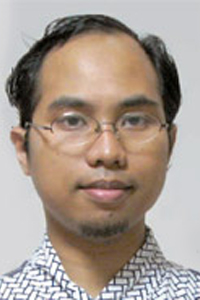 Prof. Dr. Khoirul Anwar is the founder and the patent owner of orthogonal frequency division multiplexing based 4G technology. He was the son of a local farmer and struggled financially to pay his tuition fee. He managed to get a full scholarship for four years to cover tuition fees. He pursued his bachelor degree in Electrical Engineering in Bandung Institute of Technology in 2000 and graduated with cumlaude honor. He continued his studies in Nara Institute of Science and Technology (NAIST) and got his masters degree in 2005, and got his doctoral degree in 2008. His invention got him Best Paper award for Young Scientist in Institute of Electrical and Electronics Engineers Vehicular Technology Conference (IEEE VTC) 2010-Spring in 2010. His invention was heavily inspired by Dragon Ball Z anime. In the anime, the character, Goku can absorb all energy in the universe and produced massive amount of energy. Khoirul Anwar is inspired to create a turbo decoder that can collect and absorb all energy from delayed transmission block to eliminate data distortion caused by wave interference.
Prof. Dr. Khoirul Anwar is the founder and the patent owner of orthogonal frequency division multiplexing based 4G technology. He was the son of a local farmer and struggled financially to pay his tuition fee. He managed to get a full scholarship for four years to cover tuition fees. He pursued his bachelor degree in Electrical Engineering in Bandung Institute of Technology in 2000 and graduated with cumlaude honor. He continued his studies in Nara Institute of Science and Technology (NAIST) and got his masters degree in 2005, and got his doctoral degree in 2008. His invention got him Best Paper award for Young Scientist in Institute of Electrical and Electronics Engineers Vehicular Technology Conference (IEEE VTC) 2010-Spring in 2010. His invention was heavily inspired by Dragon Ball Z anime. In the anime, the character, Goku can absorb all energy in the universe and produced massive amount of energy. Khoirul Anwar is inspired to create a turbo decoder that can collect and absorb all energy from delayed transmission block to eliminate data distortion caused by wave interference.